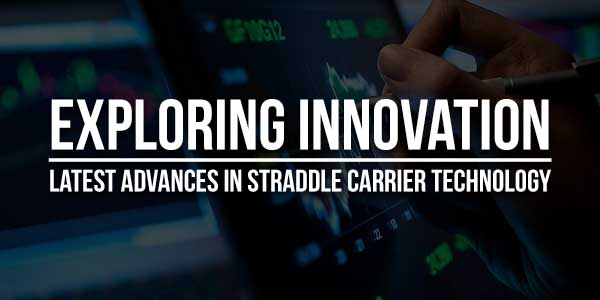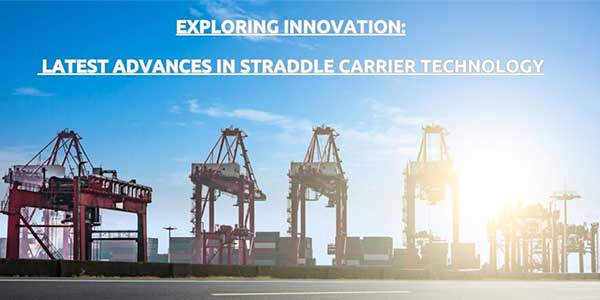
In the fast-paced world of material handling and logistics, innovation is the key to staying ahead of the curve. Straddle carriers, with their ability to lift and transport heavy loads with precision and efficiency, have long been indispensable assets in ports, container terminals, and warehouses. However, recent advancements in technology have brought about significant improvements in straddle carrier design, functionality, and performance. In this article, we’ll delve into the latest innovations in straddle carrier technology and their impact on the industry.
Table of Contents
1.) Enhanced Efficiency With Automation:
Straddle carrier technology has come a long way with advancements in automation features. Automation has significantly improved the efficiency and accuracy of straddle carriers, making manual intervention less necessary and streamlining operations. With automation, straddle carriers can navigate predefined routes with precision, pick up and stack containers seamlessly, and even perform maintenance checks autonomously.
This level of automation not only increases productivity but also improves safety by minimizing the risk of human error. Automated straddle carriers can operate 24/7, reducing the need for workers to perform repetitive tasks and minimizing the risk of injury or fatigue.
Moreover, the integration of sensors and cameras in automated straddle carriers enables them to detect potential hazards and avoid collisions, further enhancing the safety of the operation. The technology is transforming the logistics industry, making cargo handling more efficient, safe, and cost-effective.
2.) Smart Sensing And Navigation Systems:
In recent years, the advancements in sensing and navigation technologies have revolutionized the way straddle carriers operate. The modern-day straddle carriers are now equipped with highly advanced sensing and navigation systems that allow them to operate efficiently in dynamic environments. These systems employ a range of cutting-edge technologies such as LiDAR (Light Detection and Ranging), GPS (Global Positioning System), and radar to detect obstacles, monitor surroundings, and navigate complex layouts with precision.
The use of smart sensing capabilities enables straddle carriers to avoid collisions, optimize route planning, and adapt to changing conditions in real time. The LiDAR technology, in particular, helps to create a 3D map of the environment around the carrier, which is then used to plan the carrier’s path and avoid obstacles. The GPS technology, on the other hand, helps to provide accurate positioning and navigation information while the radar system detects and tracks the movement of other vehicles in the vicinity.
These advanced sensing and navigation systems have significantly improved the safety and efficiency of straddle carrier operations. They allow operators to confidently deploy these machines in busy terminals and warehouses with minimal risk of accidents or delays. With real-time information and the ability to adapt to changes, operators can ensure that straddle carriers operate at peak efficiency, reducing downtime and increasing productivity.
3.) Electric Propulsion For Sustainability:
As environmental concerns continue to grow, manufacturers have been working tirelessly to develop eco-friendly alternatives to traditional diesel-driven straddle carriers. One of the most promising alternatives is electric-powered straddle carriers, which offer several benefits over traditional models.
Firstly, electric propulsion systems emit far fewer pollutants than diesel engines, resulting in cleaner air and a healthier working environment for employees. Additionally, electric straddle carriers operate more quietly than diesel-driven models, reducing noise pollution and making them ideal for use in urban areas or other noise-sensitive environments.
Another key benefit of electric straddle carriers is their lower operating costs. While the initial investment in an electric model may be higher than a diesel-driven one, electric carriers require less maintenance and repairs, and the cost of electricity is generally lower than the cost of diesel fuel.
Perhaps most importantly, electric straddle carriers feature regenerative braking systems that capture and store energy during deceleration, further improving energy efficiency. This can make a significant difference in the long-term sustainability of a company’s operations.
By embracing electric propulsion and investing in electric straddle carriers, companies can align their operations with sustainability goals while also enjoying long-term cost savings and a cleaner, more efficient workplace.

4.) Telematics And Data Analytics:
Recent advancements in straddle carrier technology have led to the integration of telematics and data analytics capabilities, which have revolutionized the way fleet performance is monitored and managed. Through these systems, operators can now have real-time access to critical operational metrics, including fuel consumption, maintenance schedules, and equipment utilization. This data can be collected and analyzed from onboard sensors and control systems, providing insights into inefficiencies and enabling proactive maintenance.
One significant advantage of these telematics and data analytics capabilities is the ability to identify operational inefficiencies. By analyzing the data collected, operators can quickly pinpoint areas that require improvement and develop strategies to optimize equipment utilization. This leads to reduced downtime and increased productivity, ultimately resulting in cost savings for the business.
5.) Modular Design For Flexibility:
Modular design has emerged as a key trend in straddle carrier technology, allowing for greater customization and adaptability to specific operational requirements. Manufacturers offer a range of modular components and accessories that can be easily integrated into straddle carriers, such as adjustable spreader arms, telescopic chassis, and interchangeable lifting mechanisms. This modular approach enables operators to configure straddle carriers to suit different container sizes, load capacities, and handling tasks, enhancing flexibility and versatility in diverse environments.
6.) Remote Monitoring And Control:
Remote monitoring and control capabilities have become standard features in modern straddle carrier systems, enabling operators to oversee operations from a centralized location. Through web-based interfaces and mobile applications, operators can remotely monitor equipment status, track container movements, and troubleshoot issues in real time. Remote control functionality also allows operators to operate straddle carriers from a safe distance, reducing the need for personnel to be physically present on the shop floor. This not only improves operational efficiency but also enhances safety by minimizing exposure to hazardous environments.
Conclusion:
The latest advances in straddle carrier technology represent a significant leap forward in the field of material handling and logistics. From automation and electric propulsion to smart sensing and data analytics, these innovations are transforming the way straddle carriers are designed, deployed, and operated. By embracing these advancements, companies can enhance efficiency, productivity, and sustainability in their operations, ensuring they remain competitive in today’s rapidly evolving market. As technology continues to evolve, we can expect further innovations that will redefine the capabilities and possibilities of straddle carrier systems.

 About the Author:
About the Author:
















The recent advancements in straddle carrier technology mark a major breakthrough in material handling and logistics.
Welcome here and thanks for reading our article and sharing your view. This will be very helpful to us to let us motivate to provide you with more awesome and valuable content from a different mind. Thanks again.